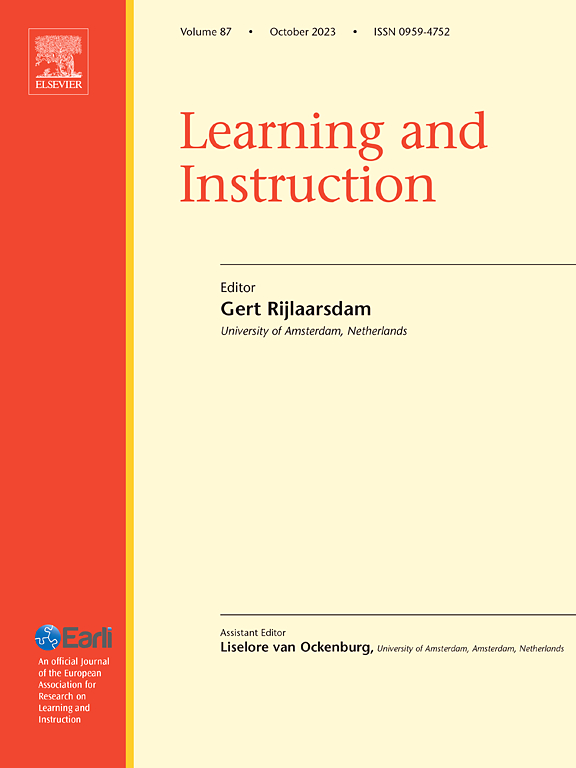同步在线学习无需网络摄像头
IF 4.9
1区 教育学
Q1 EDUCATION & EDUCATIONAL RESEARCH
引用次数: 0
摘要
背景当教师使用幻灯片进行同步在线讲座时,一个重要的考虑因素是是否打开教师的摄像机(即创建教师在场)和学生的摄像机(即创建学生在场)。目的本研究主要关注同步在线课程中教师在场和学生在场对学习成果(保留和转移测试)、主观评分(学习判断、心理努力、感知难度和社交在场)和学习过程(头部运动和面部表情)的影响。本研究共招募了33名大学生。方法采用2 × 2学科内设计,对教师在场(开与关)和学生在场(开与关)进行控制。学生们来到一个模拟真实的在线教学实验室,连续四天学习不同的英语词汇,每天都有不同的条件。学习条件和材料顺序在被试之间是平衡的。结果:关掉教练的相机会导致更好的记忆和转移测试成绩,更低的社会存在评分,更多的头部运动(表明压力更小)。关闭相机不会影响学生的记忆或转移考试成绩,但确实会导致他们的面部表情更快乐,同时也会降低他们的智力努力程度和学习信心。结论实验结果与注意力分散假说一致,提示同步在线讲座不需要网络摄像头。本文章由计算机程序翻译,如有差异,请以英文原文为准。
No need for webcams with synchronous online learning
Background
When an instructor is delivering a synchronous online lecture using slides, an important consideration is whether to turn on the instructor's camera (i.e., creating instructor presence) and the student's camera (i.e., creating student presence).
Aims
This study primarily focuses on the effect of instructor presence and student presence in synchronous online classes on learning outcomes (retention and transfer tests), subjective ratings (judgment of learning, mental effort, perceived difficulty, and social presence), and the learning process (head movements and facial expressions).
Sample
Thirty-three university students was recruited in this study.
Methods
A 2 × 2 within-subject design was used in which instructor presence (webcam on vs. webcam off) and student presence (webcam on vs. webcam off) were manipulated. Students came to a simulated real online teaching laboratory for four consecutive days to learn different English vocabulary words, with a different condition on each day. The learning conditions and material sequences were counterbalanced among the participants.
Results
Turning off the instructor's camera led to better retention and transfer test scores, lower ratings of social presence, and more head movement (indicating less stress). Turning off the student's camera did not affect retention or transfer test scores, but did result in happier facial expression along with lower ratings of mental effort and confidence in learning.
Conclusions
The results are consistent with the distraction hypothesis and suggest that there is no need for webcams in synchronous online lectures.
求助全文
通过发布文献求助,成功后即可免费获取论文全文。
去求助
来源期刊

Learning and Instruction
Multiple-
CiteScore
11.30
自引率
4.80%
发文量
109
期刊介绍:
As an international, multi-disciplinary, peer-refereed journal, Learning and Instruction provides a platform for the publication of the most advanced scientific research in the areas of learning, development, instruction and teaching. The journal welcomes original empirical investigations. The papers may represent a variety of theoretical perspectives and different methodological approaches. They may refer to any age level, from infants to adults and to a diversity of learning and instructional settings, from laboratory experiments to field studies. The major criteria in the review and the selection process concern the significance of the contribution to the area of learning and instruction, and the rigor of the study.
 求助内容:
求助内容: 应助结果提醒方式:
应助结果提醒方式:


